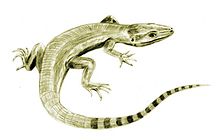| Archaeothyris Temporal range: Late Carboniferous, 306 Ma PreꞒ Ꞓ O S D C P T J K Pg N ↓ | |
|---|---|

| |
| Life restoration of Archaeothyris | |
| Scientific classification | |
| Domain: | Eukaryota |
| Kingdom: | Animalia |
| Phylum: | Chordata |
| Clade: | Synapsida |
| Family: | †Ophiacodontidae |
| Genus: | †Archaeothyris Reisz, 1972 |
| Type species | |
| †Archaeothyris florensis Reisz, 1972 | |
Archaeothyris is an extinct genus of ophiacodontid synapsid that lived during the Late Carboniferous and is known from Nova Scotia. Dated to 306 million years ago, Archaeothyris, along with a more poorly known synapsid called Echinerpeton, are the oldest undisputed synapsids known. The name means ancient window (Greek), and refers to the opening in the skull, the temporal fenestra, which indicates this is an early synapsid. Protoclepsydrops also from Nova Scotia is slightly older but is known by very fragmentary materials.

Description

Archaeothyris was more advanced than the early sauropsids, having strong jaws that could open wider than those of the early reptiles. While its sharp teeth were all of the same size & shape, it did possess a pair of enlarged canines, suggesting that it was a carnivore.
Archaeothyris' legs were articulated laterally at its pelvis and shoulders, which gave it a sprawling stance. The first toe is smaller than the second.
Classification
Archaeothyris belonged to the family Ophiacodontidae, a group of early pelycosaurs that evolved early in the Late Carboniferous. It was one of the earliest and most basal synapsids (the group which includes mammals).
Below is a cladogram modified from the analysis of Benson (2012):
| ||||||||||||||||||||||||||||||||||||||||||||||||||||||||||||||||||||||
Discovery and paleoecology
Fossils of Archaeothyris were first described in 1972 from the Joggins Fossil Cliffs, the same locality in which the early reptiles Hylonomus and Petrolacosaurus (both of which resemble Archaeothyris) were found.
Archaeothyris lived in what is now Nova Scotia, about 306 million years ago in the Carboniferous Period (Pennsylvanian). Nova Scotia at this time was a coal forest. The "trees" (actually giant club mosses) were very tall, some, such as Lepidodendron, up to 50 metres (164 ft) tall. Archaeothyris and the other early amniotes lived in the moist vegetation on the forest ground, together with the more terrestrially adapted labyrinthodont amphibians.
See also
References
- Reisz, R., 1972. Pelycosaurian reptiles from the middle Pennsylvanian of North America. Harvard University.
- Reisz, R., 1972. Pelycosaurian reptiles from the middle Pennsylvanian of North America. Harvard University.
- Falcon-Lang, H.J., Benton, M.J. & Stimson, M. (2007): Ecology of early reptiles inferred from Lower Pennsylvanian trackways. Journal of the Geological Society, London, 164; no. 6; pp 1113-1118. article
- "Archaeothyris florensis". Palaeocritti. Retrieved 13 December 2014.
- Palmer, D., ed. (1999). The Marshall Illustrated Encyclopedia of Dinosaurs and Prehistoric Animals. London: Marshall Editions. p. 186. ISBN 978-1-84028-152-1.
- Benson, R.J. (2012). "Interrelationships of basal synapsids: cranial and postcranial morphological partitions suggest different topologies". Journal of Systematic Palaeontology. 10 (4): 601–624. doi:10.1080/14772019.2011.631042. S2CID 84706899.
- Hess J.C., Lippolt H.J. (1986): 40Ar/39Ar ages of tonstein and tuff sanidines: new calibration points for the improvement of the Upper Carboniferous time scale. Chem Geol no 59: pp 143–154
Further reading
- Kemp, T. S. (2005). The Origin & Evolution of Mammals. Oxford: Oxford University Press. ISBN 978-0-19-850761-1.
External links
- Transitional Vertebrate Fossils - includes description of important transitional genera from reptile to mammal (includes a little information about Archaeothyris)
| Synapsida | |||||||||||||||||||||||||||||||||||
|---|---|---|---|---|---|---|---|---|---|---|---|---|---|---|---|---|---|---|---|---|---|---|---|---|---|---|---|---|---|---|---|---|---|---|---|
| |||||||||||||||||||||||||||||||||||
| |||||||||||||||||||||||||||||||||||
| |||||||||||||||||||||||||||||||||||
| |||||||||||||||||||||||||||||||||||
| |||||||||||||||||||||||||||||||||||
| Taxon identifiers | |
|---|---|
| Archaeothyris | |





